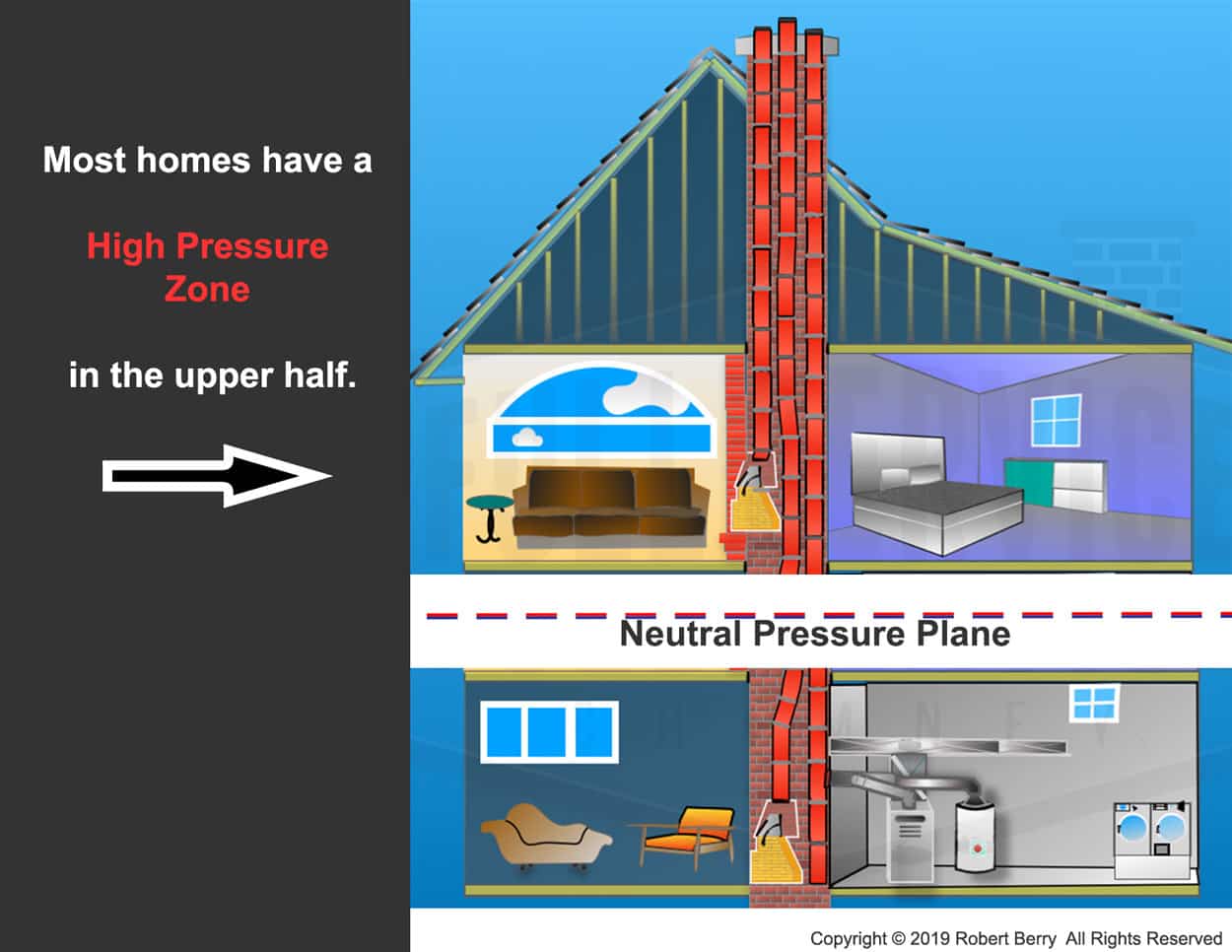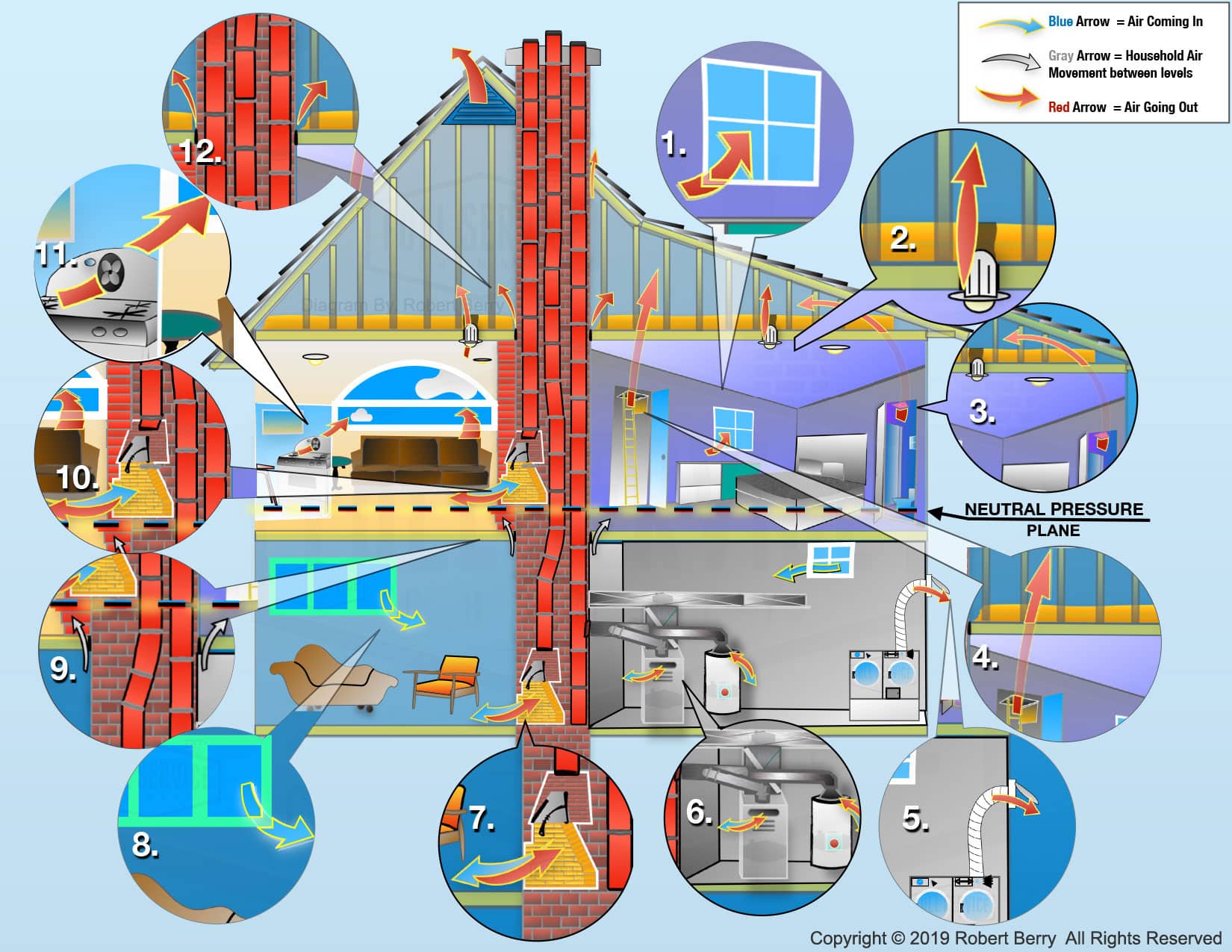Fireplace draft stops smoke from going up the chimney like it should, in turn making your time spent by the hearth a smokey mess! During the busy burning season, our chimney sweeps get frequent calls from people asking questions like “How to stop fireplace backdraft?” Or “Why does my chimney downdraft?”. Customers are usually seeking an easy solution to what is often a complex drafting problem. None-the-less whether it’s an easy fix or not, our team can help you get to bottom of it.
With the many years of experience and training received from the Chimney Safety Institute of America (CSIA) and the National Chimney Sweep Guild (NCSG) our technicians know the cause of the problem often lies beyond the chimney/fireplace.
All too often we hear this from frantic customers: “Why is smoke coming out the front of my fireplace? Can you send out a Chimney Sweep?”
While regular maintenance does a world of good, when it comes to fireplace backdraft issues a fireplace cleaning and/or chimney sweeping often is not the cure. In fact most customers are surprised to learn that chimney draft is as much a feature of the home, as it is the chimney.
Making Chimneys Work
Let’s examine the relationship the chimney draft has with the home. We’ll see the chimney and home must work together rather than against each other to perform as they should. As an added bonus to understanding air issues with the home and fireplace draft, many repairs and adjustment to make the fireplace draft properly may save us hundreds of dollars a year in heating/cooling cost and make our indoor air healthier.
First, we should understand all homes leak air in and leak air out. The reason a leak is air coming in rather than going out is due to the high/low pressures at different locations inside the home.
Most homes have a High Pressure Zone in the upper half.
This is because warm air from the heating system is buoyant (like a hot air balloon). Warmer air rises through the home until it is trapped by the ceiling and walls of the top floor. This is known as “The Stack Effect”.
Stack Effect = Chimney Effect
With warm air escaping, the home now has a negative (low) pressure in the lower half. So the home uses the same kind of gaps and openings to receive makeup air.
The point in the home where the high and low pressure zones meet (ie. the point where the pressure in the home is the same as the pressure outdoors) is the “Neutral Pressure Plane”.
Your fireplace and chimney uses indoor air for combustion and draft. If we do not want smokey fireplaces or chimney downdrafts we’ll be glad to know how our homes handle air.
Use the Number Key to understand how the home receives and expels household air.

1. Windows & Doors Above the Neutral Pressure Plane
A window fills a hole in a wall, that leads to the outdoors, the potential for air leaks exist, even when the hole is replaced with a window. In this case, because the window is above the neutral pressure plane, gaps are used to allow inside air out. This isn’t all bad.
Our homes would become stale and the household air pollutants would build up to unhealthy levels with out indoor air change. But most homes lose too much air. By minimizing warm air loss through gaps around doors and windows we lower the neutral pressure plane. Often lowering the neutral pressure plane makes fireplaces perform better, reducing odor and since less air is leaving our home, we lower utility expenses.

2. Recess Lighting
Similar to window gaps, so recess lighting allows a huge about of warm air to pass into the attic, and out of the home. Incandescent recess lighting, however, requires a free flow of air to the attic. Without the cooling of moving air passed the hot light, the risk of an attic fire is realized.
May we suggest the replacement of the old Incandescent lighting fixture with the newer (and cooler) LED light. No need for cooling air going to the attic. Depending on the number of recessed incandescent lighting fixtures your home has, this could save hundreds of dollars the heating and energy savings right away. And without your lighting loosing much of the homes air, that leaves more for the fireplace air venting needs.

3. Bathroom Exhaust Fans
Any mechanical device that removes the homes air adds to the air already leaving above the neutral pressure plane due to the Stack Effect. Just like our window or attic door air losses, so to with the exhaust fans found in most bathrooms, additional air must come in to make up for it.
NOTE: If we have a fireplace that backdrafts now and then, it could be related to the use of a fan consuming air, the fireplace needs. Once the fan is turned off, some smokey fireplaces actually work better.

4. Attic Access Door
Most frequently located in the Positive Pressure Plane, attic doors are huge, poorly sealed, openings to the attic/outdoors. Because it is not only found in the positive pressure zone, attic doors are at the highest level of the home. The air pressures exerted on them are the largest of any opening in the home. Yet these doors are some of the poorest weather stripped doors in the home.
Frequently replacing the attic access door is too large an undertaking for most homeowners, but weather stripping the door will help.
NOTE 1: Attic and/or whole-house fans ALWAYS bring fireplace odor in when used.
NOTE 2: Every cubic foot of air that passes into the attic, is one more cubic foot of air to heat, and one less for your chimney.

5. Clothes Dryer Exhaust
A properly installed dryer exhaust has minimal air loss with its flapper door. However, if it isn’t in the basement and is in the top floor, that little gravity powered door will likely gap and lose air EVEN WITH THE DRYER OFF.
With the dryer turned on, hundreds of cubic feet of household air leave the home; rising the neutral pressure plane. This forces a greater burden on the home and our lower backdrafting fireplaces.
Laundry rooms in the basement (rather than upper floors) make the most sense, due to the fact that air loss below the neutral pressure plane may lower that plane in the home.

6. Gas Chimney Downdraft
Any appliance that consumes household air in combustion and vents it out of doors is a consumer of our indoor air. The trouble is, a home will draw outdoor air through the natural vented appliance chimney, when there isn’t a heat source to force the vent to draft.
In other words, think of the chimney as a soda straw that you can blow through or drink from. So to with the homes need for makeup air in the lower levels. The home will actually draw air down the basement chimney flues, needed to replace the air lost above the neutral pressure plane. This is known as a chimney downdraft.
Chimney downdrafts could be caused by external forces, i.e., wind, or internal forces, i.e., positive/negative air pressure zones.
The Problem?
What happens when the furnace or fireplace needs to use a chimney to exhaust to the outdoors? With chimney downdraft, the water heater or fireplaces may lack the necessary heated, buoyant exhaust to reverse the backdraft. With gas appliances this could lead to carbon monoxide build up. With fireplaces…see #7.

7. Basement Fireplace Backdraft
As with backdrafting gas chimneys, so it is for basement fireplace downdraft. Once the chimney design is determined safe, then the fireplace downdraft condition is most likely due to the Stack Effect (as discussed above). That is, if its location is below the neutral pressure plane.
Chimneys lack any “check valve” that only lets smoke and exhaust out. At best, there is the fireplace or stove damper (only with wood-burning fireplaces or wood-burning stoves). Most damper mechanisms are built of crude materials, and missing any kind of gasket or weather stripping. With cast iron fireplace dampers being the most common.
Fireplace dampers are a type of fireplace backdraft stopper. The same goes for stove dampers attached to basement appliances. Even when closed, they will leak in almost as much air as when open.
There are things that will help both your hearth appliances and your furnace or water heater with chimney downdraft. With fireplaces, the addition of a chimney damper cap (installed with sealant at the chimney top) is a fairly airtight closure.
Note: Care must be taken not to install these damper caps on vented gas fireplaces, as they could be forgotten, leading to a closed damper while the gas log is going (creating a carbon monoxide hazard)!
If you’re looking to find solutions for both gas heating appliances and backdrafting basement fireplaces, consider a fireplace fresh air intake system.
Fresh Air Intake Systems are usually passive systems that encourage out door air indoors where it’s needed most. Some systems clean and warm the air prior to introducing it to your home. While the idea of letting outdoor air in, during a time of year we’re trying to keep as much heat as possible consider this…
The home will get this air anyway it can, so why not control what is already naturally happening?
A fresh air intake system has other benefits as well as lowering the Neutral Pressure Plane. Indoor air is sometimes as polluted as inner industrial city air, unhealthy and stale. Fresh air intake systems ensure an exact amount of fresh air is introduced to you and your home. More often than not, with reduced pollutants and humidity, most homeowners do not see a jump in utility flue bills and enjoy a healthier lifestyle.
Imagine, enjoying that backdrafting fireplace for the first time in years!

8. Windows/Doors Below the Neutral Pressure Plane
As with example #1 so is true with windows in our negative pressure plane. It’s not the gaps and cracks so much as the pressure in the location of the gap that truly makes an air leak. With lower levels of the home under the influence of reduced air pressure (due to the stack effect and other sources of indoor air loss) outside air is leaking in trying to relieve the air lost to the same gaps above the neutral pressure plane. These particular leaks, if not excessive, help with our desire to lower the neutral pressure plane and our homes need for fresh air. With our backdrafting basement fireplace, every cubic foot of air coming into our basement (not through the fireplace) helps with that and every other venting appliance in the home.
When our chimney sweeps help home owners with fireplace backdrafting issues we frequently recommend sealing cracks and weather striping windows and doors above the neutral pressure plane, not necessarily below.

9. Air Movement Between Floors of Your House
While the focus of the article has been on air movement between the indoors and outdoors, it’s worth mentioning one this fact:
If air movement is unrestricted, then it is challenging to affect the influences of the stack effect between floors of a home.
Sure we can close the basement door to limit the amount of warm indoor air passing upstairs, but with HVAC ducting and chimneys passing from the basement to the attic, there is no stopping it.
Proper firestops around plumbing, electrical systems, and chimneys are safety measures that will help. However, until we put exterior rated doors (with weather stripping) and install a separate heating and cooling system for each floor (zone heating) can we hope to measurably throttle floor to floor air movement caused by the stack effect.

10. Living Room Fireplace Backdraft
Fireplaces and their chimneys located on the mid/upper floors of a multi-story home frequently do not suffer from the same problems as basement fireplaces, e.g., fireplace backdraft, odor, or cold downdrafts. This is not because they could be built better, rather, most mid/upper fireplaces are frequently located at, or above the neutral pressure plane.
While this seems like the Stack Effect is working and it’s finally all good, consider this…
If our living room fireplace is leaking air out, even when it’s not in use, this adds to the negative air pressure issues, making our negative pressure zone in the basement all the more serious.
Just like a leaky attic door or window without weather stripping in the upper bedrooms so with our living room or master bedroom fireplace, we must minimize air loss when we’re not burning a fire. Proper fireplace dampers are a good start.
Remember to open the damper at the beginning of a fire and close it after the coals are extinguished.

11. Kitchen Exhaust Fans
During recent years of research and discovery on indoor air pollution caused by cooking food in our homes, two facts have surfaced:
- Indoor air quality is dirtier than outdoor air.
- Vacuuming air out of our homes with exhaust fans can produce more indoor polluted air.
So too with kitchen exhaust fans, used to evacuate odors from the cooking area to the out doors. Unlike a fireplace and chimney exhaust fans force the movement of air by mechanical means, not the use of draft and flow.
A kitchen range fan can move more air than a fireplace and if the home is unusually airtight, many homeowners have found out the hard way that they can’t have both the exhaust fan and wood-burning fireplace on at the same time!
Exhaust fans act like an open window unless there are shutters that open and close them. Care should be taken when they’re in use.

12. Chimney Firestops
As with all devices that run through multiple floors, the chimney should be built to keep air movement into the attic at a minimum. Fire stops do this with the use of thin sheets of metal between the attic and the chimney. If fire stops are missing, not only could there be an air leak into the attic but in the event of a fire, flames could spread around the chimney unhindered.
Understanding the home and chimney dynamics are helpful when we’re wanting to maximize our enjoyment of fireplace and hearth products.
Checkout the next post in this two-part series discussing when fireplace backdraft actually is a chimney issue. Part 2: Fireplace Backdraft & Downdraft | Troubleshooting
Recommended Article: Basement Fireplace Problems




